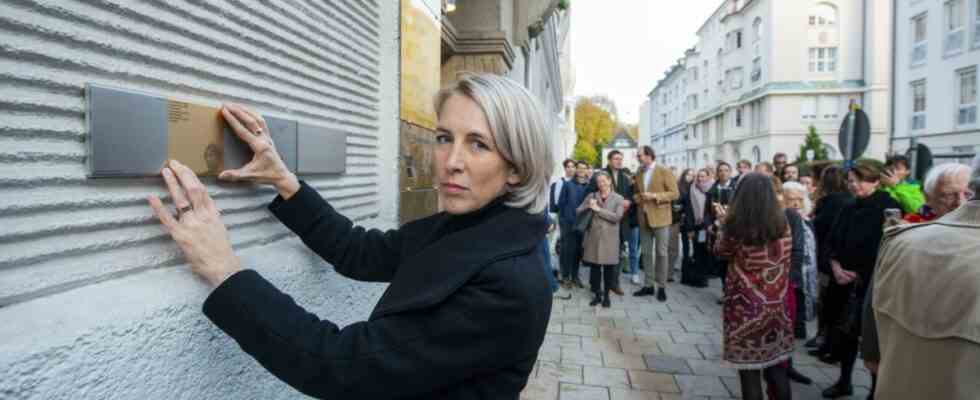Aside from being one of the most coveted addresses in the city, Ohmstraße in Altschwabing is a completely normal residential street in Munich. This is precisely what makes the starting point of a new citizens’ project, which is intended to document the history of its Jewish residents during the Nazi era as completely as possible, so shocking: At least 200 Munich residents of Jewish origin lived 340 meters between Leopoldstrasse and Königstrasse, 90 of them persecution, war or escape did not survive.
As the historian Matthias Georgi, who was involved in the project, explained at the opening event, Jewish fellow citizens must have lived at every second of the 20 addresses. In the coming years, the residents want to work together to ensure that a corresponding number of houses bear commemorative signs, i.e. the blackboards and steles that have been attached to or in front of Munich facades for four years. The extent of the persecution should become visible – at least pars pro toto.
There were three such signs before the new memorial project on Ohmstrasse, and four more on the corner of Ohmstrasse and Königinstrasse. With the installation of three additional signs for Irma Hecht, Eugen Doernberger and Hermann Raff on the house at Ohmstraße 13, the initiative can already show visible results right from the start. Corona had meant that experts and laypeople went behind the scenes into the archives and researched long before the start could take place on the third attempt.
Extraordinary project: Charlotte Knobloch, President of the Jewish Community in Munich and Upper Bavaria, praises the memorial project.
(Photo: Tom Hauzenberger)
The President of the Jewish Community, Charlotte Knobloch, speaks of an “extraordinary, I am deliberately not saying: unique” project. Jan Fischer, an entrepreneur based on Ohmstraße, provided the impetus and financial support a good three years ago. Project partners have been found, among others, with the Munich Institute for Urban History and Remembrance Culture, the history research agency Neumann & Kamp and, last but not least, with a working group at the Oskar-von-Miller-Gymnasium in Schwabing. Since the beginning of the year, almost ten high school students have collected and organized material there.
The new commemorative signs commemorate three related and yet different fates, which were reconstructed in very different ways – an outlook of what awaits the honorary Schwabing historians and their professional companions: At his time in the city’s public life, the general Pediatrician Eugen Doernberger, born on March 3, 1867. During the First World War, Doernberger worked as a ship’s doctor, among other things, and then treated the wounded in the street battles for the Soviet Republic of 1919. His later activities in the social work of the religious community and at the municipal health department are quite well documented. With his own voice from the past, he speaks as the author of studies on the health of schoolchildren, also at the Oskar-von-Miller-Gymnasium. Doernberger died, persecuted, deprived of his rights and robbed, on March 21, 1938. His widow emigrated to Uruguay in the same year.
Worn down by the terror regime: Hermann Raff.
(Photo: private)
The story of the lawyer Hermann Raff, born on August 23, 1868, can be outlined primarily from family documents. His marriage to his non-Jewish wife Katharina Siegel protected him from deportation, but not from all other forms of harassment and repression. During the night of the pogrom he escaped arrest by hiding on an alpine pasture in the Tegernsee mountains. He later hoped to escape the terror in Füssen, where he died on September 19, 1943. Raff’s story also bears witness to how the persecutors mentally demoralized their victims. Peter Troberg knows how his grandfather was only just able to be prevented by his son, Troberg’s uncle, from throwing himself from the Echelsbach Bridge into the Ammer Gorge.
Deported to Kaunas and murdered: Irma Hecht, here her identity card from around 1938.
(Photo: Munich City Archives)
Irma Hecht was born on November 6, 1885 in Nuremberg and has lived in Munich since 1901, where she worked as a private teacher for ancient languages and as a research assistant at the Ludwig Maximilian University (LMU). During the Nazi period, constantly changing residences in Schwabing are documented, including in the Pension Atlantik on Ohmstraße. On November 20, 1941 she was deported to Kaunas (Lithuania) and shot there on November 25. It was the first of a total of 42 deportation trains from Munich and one of the first groups of victims to be murdered immediately on arrival. Her sister Emmy managed to escape in 1940 and died in New York in 1971. Irma Hecht’s story has only left scattered traces in official and university archives and remains a project in progress for historians and research laypeople.
Historian Georgi makes it clear to all those involved and interested that one has to remain on guard: Even his guild regularly “falls into a trap” when it comes to evaluating post-war files, for example. Their apparently neutral authors often “covered everything up in order to cover up crimes”. Seen in this way, what initiator Fischer claims to be the highest achievable goal of the campaign has only just begun: “At least one layer of civilization on top of a huge heap of shame.”

